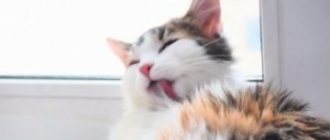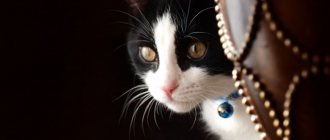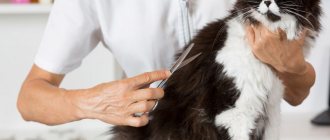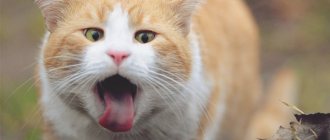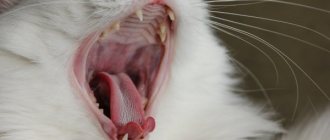Common Causes of Vomiting in Cats
Why does a cat vomit? The most common reasons are the following:
- eating large amounts of food, quickly absorbing food, swallowing large pieces;
- taking food after a long fast, in case of infrequent feeding (food in the bowl of cats, unlike dogs, must be constantly present, since the animal eats often, but little by little);
- the presence of fur in the gastrointestinal tract, which enters it during licking, accumulates, and then is expelled out through the oral cavity;
- poisoning from household chemicals, poor-quality food, plants, and so on;
- injuries, for example, falling and bruising the head, spine, damage to internal organs;
- cleansing the gastrointestinal tract, for example, using fresh grass, which cats specifically eat for this purpose;
- the reaction of the pet’s body to potent medications during the treatment of any disease;
- feeding newborn kittens - a nursing cat regurgitates partially digested food and “feeds” the cubs so that their gastrointestinal tract gradually adapts to future food.
Vomiting in a cat may indicate the presence of a disease that requires diagnosis and specific treatment. This could be: feline distemper, enteritis, calicivirosis, helminthiases, thyroid diseases, pathologies of the vestibular apparatus and others.
Prevention
Despite the fact that vomiting hair is almost a physiological inevitability for cats, loving owners should do everything possible to avoid it.
The first thing you need to do regularly (especially for medium- and long-haired breeds) is to thoroughly comb your pet. Cleaning the “fur coat” helps rid the animal of most of the dead hairs, and he does not have to independently pull them out with his tongue and swallow them. The less such “garbage” gets into the cat’s stomach, the less often she will have the urge to vomit with trichobezoirs.
To prevent ingestion of fur, the cat must be combed
Don’t forget about the availability of fresh grass for your cat; it’s best to place a pot of sprouts right next to the food bowl.
The cat’s body’s protective reaction is to regurgitate hairballs, which it has to tear out and swallow when licking. The situation may frighten inexperienced owners, but it is absolutely physiological. It should be remembered that repeated vomiting of fur can be a symptom of serious health problems that need to be addressed with your veterinarian. One-time cases of hair vomiting can be dealt with by regularly brushing the cat, giving it “anti-hair” pastes, as well as correctly forming the diet, enriching it with fresh grass.
Cat pregnancy as a cause of gag reflex
Experts have not come to a consensus on the issue of toxicosis in cats during pregnancy. However, owners of pregnant pets often observe the urge to vomit, especially in the morning. As a rule, this phenomenon is caused by hormonal changes in the body, occurs in the second week of fetal development, and its duration does not exceed 10-14 days.
If there are no suspicious inclusions in the vomit, the body temperature is normal, and the stool is normal, then there is no cause for concern. If the animal’s condition worsens, other symptoms appear, vomiting becomes profuse, frequent, severe, with impurities, it is necessary to show the cat to a veterinarian. Otherwise, the risk of losing not only the unborn offspring, but also the mother increases.
Is it possible to find out the cause by the appearance of the vomit?
In some cases, the appearance and/or nature of vomiting in cats can suggest its cause.
Type of vomiting
Possible reasons
Vomit is yellow
A yellowish tint can be a result of feeding your pet food with dyes, but more often the cause is helminthiasis or problems with the liver and gall bladder. Such vomiting has a pronounced yellow color and is possible with severe intoxication of the body, poisoning, consumption of fatty foods, and certain medications.
Vomiting fur
A normal phenomenon is that the gastrointestinal tract gets rid of the accumulation of wool, which is not digested and does not enter the intestines.
White vomit, foam, with or without mucus
It is a secretion of the stomach, mucus that protects its walls. This type of vomiting in a cat can be caused by overeating, parasitic diseases, developing gastritis, ulcers, viral or bacterial infections. Possible during fasting. A single attack is not dangerous.
Gray vomit with pieces of food
Occurs in case of overeating and contains undigested food residues. It can occur during pregnancy of a cat, with obstruction of the intestinal tract, inflammation of the gastrointestinal tract, or volvulus.
Green vomit
A green tint can be caused by: poisoning, intestinal infections, liver and gall bladder diseases, and oncological pathologies.
Vomiting blood
Provoking factors: chemical (for example, taking medications) and mechanical injuries to the gastrointestinal tract, oncology, peptic ulcer. A crimson, dark brown tint may indicate a pathology in the stomach or duodenum, while bright blood may indicate damage to the esophagus or oral cavity.
Black color of vomit
It may be due to intestinal obstruction or the use of certain medications (for example, activated carbon in case of poisoning).
Symptoms of having fur in the stomach
Why does a cat vomit after dry food?
To avoid further problems with the gastrointestinal tract, the owner of the animal must be able to recognize the situation when excess hairy mass accumulates in the pet’s stomach and it is necessary to take action. So, the warning signs are:
- The animal refuses to eat or eats less than the usual portion because the stomach is already filled with hairballs. The cat will constantly stomp around the bowl, as if not knowing what to do, because the level of glucose in the blood is low from hunger, but the stomach is full.
- The fur becomes dull and no longer shines, which is caused by the animal not receiving the necessary nutrients.
- Periodic coughing and urge to vomit. The larger the resulting lump, the more difficult it is for the animal to get rid of it when the cat vomits hair because the gastric sphincter does not open wide enough.
- The presence of stuck (or worse, ingrown into the gums) hairs on the cat’s teeth. Having discovered them, it is necessary to take measures to clear the digestive tract of trichobezoars.
- The cat becomes lethargic and apathetic, constantly sleeps and does not play, as usual, avoids communication.
- Constipation that lasts more than one day. This situation can arise as a result of the stomach being completely filled with swallowed wool and often leads to general intoxication of the animal’s body.
- The cat is vomiting in masses mixed with blood.
When to urgently contact a veterinarian
You need to quickly take your cat to the clinic in the following cases:
- impotence (the animal cannot rise);
- vomiting does not go away within 1-2 days;
- urges become frequent (more than 3 times a day);
- the cat cannot drink water on its own;
- black masses with the smell of feces;
- body temperature rises;
- convulsions appeared;
- breathing is impaired;
- repeated vomiting of blood or bile;
- rapid deterioration of the cat's condition.
What to do: treat or not treat?
In the case of the classic manifestation of hunger vomiting, the cat should not be treated. If vomiting occurs once, the cat feels normal and there are no other symptoms of the disease, the animal is simply given something to eat - the vomiting does not recur after that.
If there are symptoms of ill health, even minor ones (lethargy, poor appetite, dull fur, etc.), if the cat continues to vomit repeatedly, you need to give the animal a sorbent and put it on a starvation diet. This is something the owner can do as first aid. Immediate consultation with a veterinarian is indicated next.
This article was checked and approved by Tatyana Kudinova, a candidate of biological sciences, veterinarian, felinologist, owner of the Lovely LapaTan nursery, a researcher at a company developing probiotics for animals, and a co-author of articles in scientific veterinary publications. More detailed information can be found by going to the expert’s personal page. GO ⇒
Treatment of vomiting in a veterinary clinic
Treatment of vomiting in a cat depends on its nature: an acute attack is eliminated by symptomatic therapy, and a chronic course requires a thorough examination of the pet (ultrasound, endoscopy, laparotomy) and the use of appropriate methods (medication, surgery, endoscopic). In each case, the therapy will be different. For example, if a hairball gets stuck in the stomach or intestines, it is removed by endoscopy, after which the animal is prescribed anti-inflammatory therapy.
Obstruction of the pylorus of the stomach, tumors, and the presence of foreign objects in the pet’s gastrointestinal tract suggest surgical treatment (sometimes endoscopy). In case of severe inflammation in the intestines, the veterinarian may prescribe hormonal medications and supportive medications. Diseases of the liver and gall bladder require the use of antibiotics, anti-inflammatory and choleretic drugs, corticosteroid drugs, and immunosuppressants.
Why do hairballs form?
Scientifically, the wool balls or sausages that form in the stomach and intestines of a cat are called trichobezoar (“hair tumor”) - a mixture of hairs, food debris and gastric mucus.
Sometimes a cat vomits hair
The reason for their formation is that representatives of the cat family carefully care for their fur using their tongue. The fact is that it is covered with small hook-shaped growths, which, when licked, pick up hairs. Next, individual hairs pass into the animal’s stomach, where they accumulate in the form of balls or sausages and are periodically released with vomit.
Small accumulations pass through the digestive tract further into the duodenum and small intestine, then are excreted in the feces. A large lump can get stuck in the intestines and cause constipation or obstruction, stricture and esophagitis.
Hairballs from a cat's stomach
Natural causes
If the ingested hairs are not excreted, the cat will periodically regurgitate the hair to remove these non-food items from the stomach. Because the wool masses pass through a narrow esophagus, they look like sausages. In this case, vomiting is accompanied by coughing sounds.
In long-haired breeds (Persians, Maine Coons and others), this natural cause of the formation of trichobezoars is most common - they can spend more than 10% of their time licking their coat.
Cats swallow fur when licking themselves.
Additional Information! Kittens practically never have such lumps in their vomit, because they are licked by the mother cat, but as they grow, vomiting of swallowed fur in a young cat becomes more and more common.
The cause of vomiting itself can also be grass specially eaten by the animal for cleansing.
Dangerous reasons
If your cat vomits hair quite often, you need to visit a veterinary clinic so as not to miss the onset of a serious illness in your pet.
So, some dangerous reasons why a cat pulls out hairballs and swallows them are:
- Flea infestation. At the same time, the volume of ingested fur sharply increases as a result of itching from bites.
- Allergic dermatitis and other skin problems, the symptoms of which are unbearable itching.
- Being in stressful situations, when the animal licks itself to calm itself, as well as as a result of increased excitability of the sympathetic nerves.
- Chronic diseases of the gastrointestinal tract due to an inappropriate diet, accompanied by impaired motility of the upper digestive tract.
- Diabetes, kidney and thyroid diseases, intestinal inflammation.
How to help a cat at home
What to do if your pet is vomiting? First of all, you should place the cat in such a way that the head hangs slightly, which will prevent the contents from flowing back into the esophagus.
Pharmacological agents at home must be selected carefully:
- sorbents (Smecta, Enterosgel) will help relieve intoxication in case of poisoning;
- taking antiemetic drugs will reduce the frequency of urges (Cerucal);
- relieve spasms in the gastrointestinal tract, you can eliminate pain with the help of No-shpa;
- Regidron will help restore water balance and prevent dehydration.
Attention: in case of poisoning, the body tries to remove toxic substances through vomiting, so giving antiemetics is not recommended. On the contrary, you can try to evoke a reflex in the cat by pressing on the root of the tongue with your finger, after first drinking it with warm salt water (the larger the volume, the better, until a gag reflex occurs).
You can support your pet by periodically giving him a decoction of chamomile, oats or flax seed. Be sure to give plenty of water. If the animal refuses to drink on its own or cannot, it should be given water from a spoon, poured into the mouth with a syringe or a rubber bulb.
How to feed a cat when vomiting
At the clinic, the specialist will definitely recommend putting the cat on a gentle diet or keeping it on a fast for 1-2 days. Fasting allows the mucous membrane to recover after vomiting. The presence of an inflammatory process in the gastrointestinal tract prevents the complete breakdown and absorption of food, so any food will not only be useless, but will also lead to new attacks.
In case of one-time vomiting not associated with diseases of the digestive tract, feeding the animal after some time is allowed. As a rule, the cat itself lets you know about it. In such cases, the first meals are a diet menu that excludes fatty and protein foods. You can include in your diet: rice water, vegetable puree (for example, intended for children), low-fat broth. If your pet is accustomed to industrial food, then you need to choose special offers from the medicinal category.
Is vomiting dangerous for your pet?
Single vomiting in cats, in the absence of a disease provoking it, does not pose a danger. A frequent and abundant reflex can lead to serious consequences: the immune system weakens, the body’s energy reserves are depleted, and the pet becomes vulnerable to infections.
But the main danger is dehydration, especially if vomiting is accompanied by diarrhea. You can check whether there is significant loss of water in the following way: grab a piece of skin on the animal’s body and pull the fold slightly. If there is a sufficient level of fluid in the tissues, it will quickly straighten out, otherwise the fold will remain or return to its original position after some time. The latter option means that the cat needs to be urgently taken to the clinic for emergency measures.
How to prevent vomiting
Preventive measures to prevent vomiting in a cat:
- provide high-quality food, balanced in composition, without harmful additives that negatively affect the liver;
- when switching to another diet, introduce it gradually;
- stick to one type of feeding (for example, do not “jump” unnecessarily from dry food to natural food);
- deworm the animal in a timely manner;
- get vaccinated against infectious feline diseases, agree on a vaccination plan with your veterinarian and stick to it;
- brush your pet periodically;
- protect your cat by limiting access to household chemicals, rodent poisons, and medications;
- keep bowls clean;
- Avoid prolonged fasting or excessive consumption of food by animals.
It must be remembered that vomiting is not only a symptom indicating a problem in the cat’s body, but also a condition that is potentially life-threatening for the animal. An attentive owner will be able to guess the cause of vomiting and take the pet to the clinic, or provide home treatment. Compliance with preventive measures will help avoid an unpleasant situation in the future.
Preventive measures
Compliance with preventive measures will avoid the problem of indigestion of food. What to do?
- The pet should always have access to clean water, especially if the diet is dry;
- You shouldn’t skimp on your pet’s health; its stomach needs high-quality nutrition. It is better to give him premium food;
- It is better to divide feeding into 4-5 times in small portions, so the cat will not overeat;
- worm your pet regularly, as worms and parasites also interfere with digestion;
- it is also necessary to choose the right food in accordance with the breed, age and condition of the pet;
- Be sure to regularly visit the veterinarian and carry out preventive vaccinations.
Important! You cannot give your pet medications or treatment on your own without a doctor’s recommendation. The owner may incorrectly determine the diagnosis, and attempts to save the pet will only hasten its death.
Natural product
If your cat vomits from food, you should get treatment as soon as possible. Rather than putting off going to the doctor or hoping that it “will go away on its own,” it is better to take measures as soon as possible so that the pet will delight its owner with its love and health for a long time.
